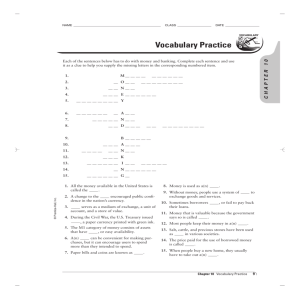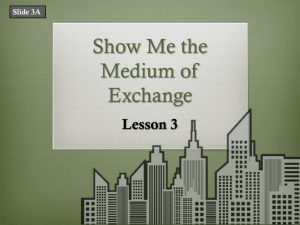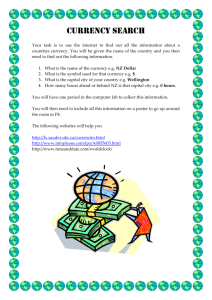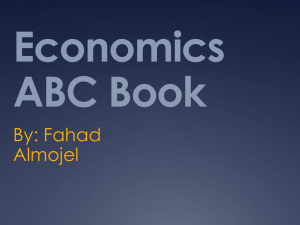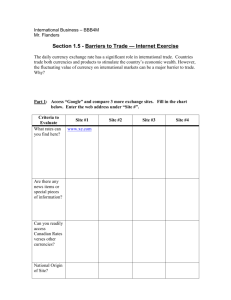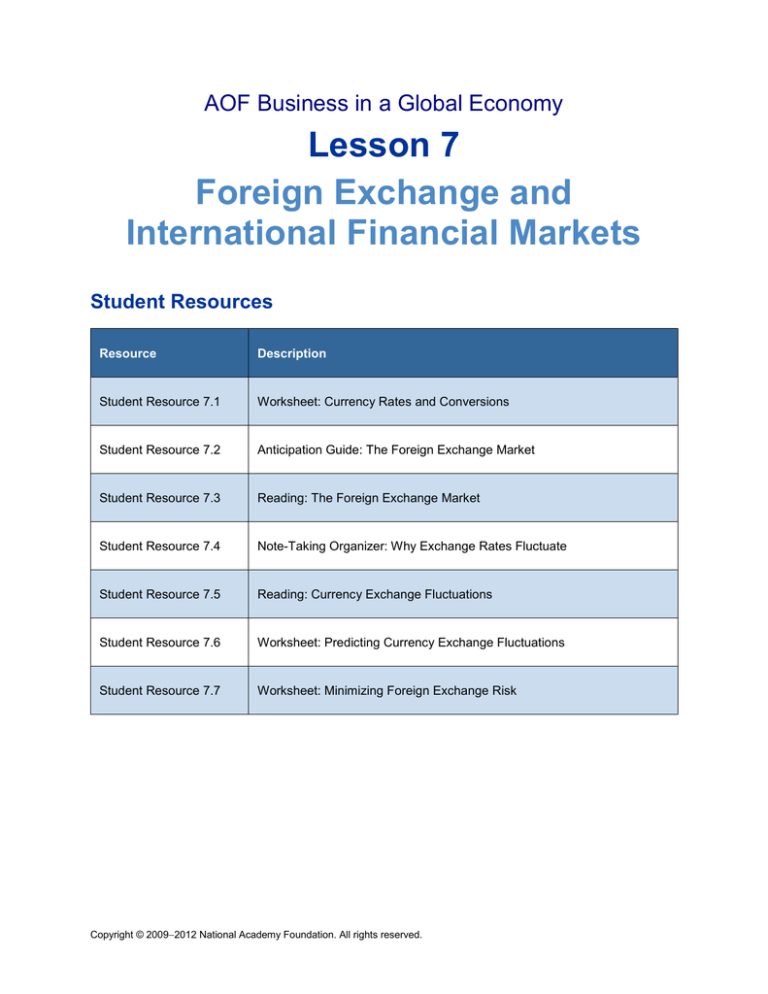
AOF Business in a Global Economy
Lesson 7
Foreign Exchange and
International Financial Markets
Student Resources
Resource
Description
Student Resource 7.1
Worksheet: Currency Rates and Conversions
Student Resource 7.2
Anticipation Guide: The Foreign Exchange Market
Student Resource 7.3
Reading: The Foreign Exchange Market
Student Resource 7.4
Note-Taking Organizer: Why Exchange Rates Fluctuate
Student Resource 7.5
Reading: Currency Exchange Fluctuations
Student Resource 7.6
Worksheet: Predicting Currency Exchange Fluctuations
Student Resource 7.7
Worksheet: Minimizing Foreign Exchange Risk
Copyright © 20092012 National Academy Foundation. All rights reserved.
AOF Business in a Global Economy
Lesson 7 Foreign Exchange and International Financial Markets
Student Resource 7.1
Worksheet: Currency Rates and Conversions
Student Names:_______________________________________________________ Date:___________
Directions: Before you begin, record the name of the currency exchange rate source you are using and
today’s exchange rates. (Abbreviations for each currency are provided in parentheses.) Then work with a
partner to calculate the exchange rates for these problems before answering the questions. Be ready to
share your answers with the class.
Currency Exchange Rate Source:____________________ Today’s Date:___________
Cur
Currency
Japanese Yen
British Pound
Indian Rupee
Brazilian Real
S. African Rand
(JPY)
(GBP)
(SR)
(BRL)
(ZAR)
Exchange Rate
(1 USD = ?)
1. Sample Problem: I am going to visit my cousin in England this year. He said I should take at least
400 British Pounds worth of spending money. How many US dollars is that?
2. Our shipping company is buying an apartment in Brazil for visiting executives to stay in. It is
unfurnished. The accountant is trying to figure out if it would be cheaper to buy the furnishings in
the US and ship them to Brazil, or if it would be cheaper to buy them there. Shipping will total 10%
of the cost of the items, if they are bought in the US. Using today’s exchange rate, calculate the
costs of these items from US dollars (USD) to Brazilian real (BRL). Then, add the shipping costs
and figure out which option will be more cost effective. The items you must buy and their costs in
each country are:
a. Couch
USD Price 1,000
BRL Price 4,200
b. Bed
USD Price 2,200
BRL Price 4,000
c.
USD Price 1,250
BRL Price 3,050
d. Bedding
USD Price 100
BRL Price 25
e. Washer and dryer
USD Price 950
BRL Price 2,200
Refrigerator
Do your calculations on a separate sheet of paper and write your recommendation here:
Copyright © 20092012 National Academy Foundation. All rights reserved.
AOF Business in a Global Economy
Lesson 7 Foreign Exchange and International Financial Markets
3. You have been assigned to visit some clients in a few different countries for 10 days. Your boss
would like an expense report in US dollars when you return. Calculate the cost of your meals and
hotels for the expense report for your boss and the total cost of the trip.
Cape Town, S. Africa: days 1–3
Bangalore, India: days 4–7
Leeds, England: days 8–10
Hotel Costs: 942 Rand (ZAR)
Hotel Costs: 750 Rupees (SR)
Hotel Costs: 984 Pounds (GBP)
Meal Costs: 431 Rand
Meal Costs: 194 Rupees
Meal Costs: 329 Pounds
Total Spent:
Total Spent:
Total Spent:
US Dollar Conversion:
US Dollar Conversion:
US Dollar Conversion:
Total spent on the trip in US dollars:
4. Your firm has asked you to research a new supplier for its raw materials of rubber, copper, and
wood. Calculate the cost of the materials and recommend the country it would be most costeffective to get each from.
rubber
India: 3 SR/kilo
S. Africa: 12 ZAR/kilo
Brazil: 12 BRL/kilo
Japan: 42 JPY/troy ounce
India: 22 SR/troy ounce
Brazil: 14 BRL/troy ounce
England: 655 GBP/cord
Brazil: 389 BRL/cord
S. Africa: 545 ZAR/cord
cost in USD
copper
cost in USD
wood
cost in USD
From which country should your firm get each raw material, based on the cost of buying it in the
country it comes from?
Can you think of any other costs that should also be taken into account, and that might influence
which country you advise your firm to choose?
Copyright © 20092012 National Academy Foundation. All rights reserved.
AOF Business in a Global Economy
Lesson 7 Foreign Exchange and International Financial Markets
Student Resource 7.2
Anticipation Guide: The Foreign Exchange Market
Student Name:_______________________________________________________ Date:___________
Directions: For each of the statements below, underline “I agree” if you think the statement is accurate or
“I disagree” if you disagree with it. Write one reason to explain your guess. After you read Student
Resource 7.3, Reading: The Foreign Exchange Market, check your answers, correct them if necessary,
and fill in the “I learned” section for each statement.
The foreign exchange market never closes.
My guess:
I agree
I disagree
My reason:
I learned:
Travelers who need foreign money make up the majority of currency exchanges.
My guess:
I agree
I disagree
My reason:
I learned:
Banks lose money because of currency exchanges.
My guess:
I agree
I disagree
My reason:
I learned:
The emotions of FX traders actually impact exchange rates.
My guess:
I agree
I disagree
My reason:
I learned:
Copyright © 20092012 National Academy Foundation. All rights reserved.
AOF Business in a Global Economy
Lesson 7 Foreign Exchange and International Financial Markets
Student Resource 7.3
Reading: The Foreign Exchange Market
What is the Foreign Exchange Market?
When businesses, individuals, or governments need money (currency) to buy foreign goods or services
or invest in another country, they must usually exchange their home currency for the foreign one to make
the transaction. These transactions occur on the foreign exchange market, which is also called the Forex,
or FX, market. It is the largest market in the world. Over 1.2 trillion dollars are traded daily on FX, and it is
the only market that is open 24 hours per day. FX is a worldwide network of traders who connect with
each other and trade over the phone and the Internet. Because FX trading does not have a central
location, trades occur all over the globe; the difference in time zones allows trading to occur all day and
night, though most trading occurs in New York, London, England, and Tokyo, Japan.
Who Trades on the FX Market?
There are four main types of traders in the FX market.
Banks are responsible for about 2/3 of the market trading volume. They buy and sell currency to
and from each other to make profits. Banks trade currency with each other at special, unpublished
rates.
Brokers are dealers who represent the banks on the FX market for some of their FX trading,
finding the best exchange rates on behalf of the banks. Brokers allow banks to remain anonymous
in their currency trading. They earn money by charging commissions on their transactions.
Customers of FX mostly consist of large companies who need foreign currency to make
purchases or investments. Other customers are individuals or smaller firms who require foreign
currency for travel or purchases.
Central banks (for example, the US Federal Reserve, the European Central Bank, and the Bank of
England) sometimes participate in the FX market to influence the value of the currency they are
responsible for. Central banks in some countries (notably China) buy or sell currency, or issue
new currency to keep their currency’s exchange rate near a target rate they have set.
Why do they trade?
There are three main reasons traders exchange currency on the FX market. The first is to earn short-term
profits from fluctuations in exchange rates. Investors, both big and small, can make profits because of
exchange rate fluctuations, and banks and large international corporations hire currency managers to buy
and sell currencies every day. The second reason is that firms must have the correct currency to buy the
goods and services needed for their operations all over the world. The third reason for FX trading is for
protection from losses due to currency fluctuations. Firms dealing with large amounts of money can gain,
but also lose, from even the smallest fluctuations in currency exchange rates.
Why do exchange rates fluctuate?
Exchange rates fluctuate for three main reasons. The first is economic factors, including a country’s
interest rates, its inflation rate, and the supply of and demand for its currency. The second reason
exchange rates fluctuate is because of political conditions; generally, the more stable a country’s politics,
the less widely its currency fluctuates. Finally, market psychology causes exchange rate fluctuations.
Market psychology is the general “feeling” of the market. If there is fear or excitement about a currency,
its price will be affected. Anyone making currency trades must be aware of these three factors to minimize
their trading risk.
Copyright © 20092012 National Academy Foundation. All rights reserved.
AOF Business in a Global Economy
Lesson 7 Foreign Exchange and International Financial Markets
Student Resource 7.4
Note-Taking Organizer: Why Exchange Rates
Fluctuate
Student Name:_______________________________________________________ Date:___________
Directions: Fill in this table with the information you learn from the presentation.
The Foreign Exchange Market (FX) is where:
The value of a currency is
determined by the law of:
Three factors affect the value of
a currency.
A fixed rate is:
One benefit of a fixed rate is:
A floating rate is:
One benefit of a floating rate is:
P_______________ Influences
include:
E______________ Policy and
include:
1.
2.
Conditions
3.
Market __________________
is a phenomenon when
_______________________
are influenced by:
rates
Governments manage currency
in different ways. One is:
A strong currency is:
and is exhibited by:
A weak currency is:
and is exhibited by:
Copyright © 20092012 National Academy Foundation. All rights reserved.
AOF Business in a Global Economy
Lesson 7 Foreign Exchange and International Financial Markets
Student Resource 7.5
Reading: Currency Exchange Fluctuations
The foreign exchange (FX) market is where traders, banks, corporations, and governments exchange
currency, that is buy or sell one country’s currency for another. This international trade in currency goes
on around the world, 24 hours a day, with the three main centers for FX trading located in the United
States, Japan, and the United Kingdom.
But how do those who trade in the FX market know how many dollars there are in a euro? Or yen in a
rupee? Let’s look at the factors that determine currency exchange rates and cause them to fluctuate.
Copyright © 20092012 National Academy Foundation. All rights reserved.
AOF Business in a Global Economy
Lesson 7 Foreign Exchange and International Financial Markets
Currency, just like any other product for sale, follows the laws of supply and demand. Its price is its
exchange rate. If many people want a certain currency and there’s not much available, that excess of
demand over supply will cause that currency’s price to rise. On the other hand, if there’s too much of a
particular currency available, compared to the demand for it, that currency’s price will fall.
The exchange rate of a country’s currency can either be floating or fixed. The value of a currency with a
floating rate is determined by the market. On the other hand, if a currency is fixed, its value is “pegged” to
another currency, group of currencies, or other measure of value, like gold. The central banks of countries
with fixed exchange rates must buy and sell their own currency to maintain the fixed exchange rate.
Some governments choose fixed exchange rates to help control inflation or stabilize their currencies. But
fixed exchange rates may fail to reflect the true value of a currency, since they do not adjust according to
market forces. If a fixed exchange rate is too different from what is consistent with market supply and
demand for the currency, the result can be a financial crisis that forces a change in the fixed exchange
rate. Therefore, most countries choose to let the exchange rate of their currency vary according to supply
and demand in the market; that is, they have a floating exchange rate.
Copyright © 20092012 National Academy Foundation. All rights reserved.
AOF Business in a Global Economy
Lesson 7 Foreign Exchange and International Financial Markets
There are a few currencies that traders in the currency market tend to prefer over others. But why? What
exactly are they looking for? Let’s compare two countries. One has a stable government and political
environment. Its economy is steadily growing, and it exports a variety of products to other foreign
markets. The second country is in turmoil, perhaps undergoing a civil war, with an economy that has little
to offer in the way of trade. In these cases, the first country’s currency would generally be more highly
valued. People, companies, and other countries will want to do business with that country and therefore
will desire its currency.
Political events can greatly affect a currency’s exchange rate. For instance, when a new government
comes into power, it brings up a variety of questions. Will the new government maintain the current
economic policies? Will its economic policies be better or worse? Will there be internal or regional political
upheaval and fighting, or is the political landscape calm and stable? Traders consider how national and
international politics affect what a currency is worth.
Copyright © 20092012 National Academy Foundation. All rights reserved.
AOF Business in a Global Economy
Lesson 7 Foreign Exchange and International Financial Markets
The economic policies of a country (which are decided by governments), and the condition of its
economy, affect the value of its currency in the foreign exchange market. Central banks such as the US
Federal Reserve have substantial control over interest rates, which determine the cost of borrowing
money.
Whether a country’s gross domestic product is increasing or decreasing also impacts the value of its
currency. Countries with growing industries see a rise in employment rates and prosperity for the nation.
When a country’s prosperity rises, its currency tends to appreciate in value.
Economic conditions also influence exchange rates in other ways. One major factor influencing the value
of a currency is inflation. When a country has high inflation, people from other countries may desire its
currency less. When there’s inflation, what you can buy with a unit of a currency—its purchasing power—
goes down. For example, a pack of gum that may have once cost $1 now costs $2 because of inflation.
Thus, inflation in a country will cause the value of its currency to depreciate in relation to other countries’
money.
Copyright © 20092012 National Academy Foundation. All rights reserved.
AOF Business in a Global Economy
Lesson 7 Foreign Exchange and International Financial Markets
Like any other human endeavor, the foreign exchange market is influenced by the perceptions and
emotions of the people involved. This is called market psychology. Investing in currency is in one way just
like making other investments in that it involves risk. Currencies in developing countries with expanding
economies are risky investments. They offer FX traders new opportunities, but these currencies often
come from less economically and politically stable countries.
Rumors and expectations play a large role in the valuation of currencies. If many traders believe a
positive event is going to happen in a country, that belief may be enough to raise the price of that
currency. Traders also place a lot of importance on specific economic statistics, although which statistics
they consider to be important may change over time. They may focus on a country’s inflation rate, trade
balance, or employment figures in an attempt to predict the price of its currency in the near future.
In a market this big and volatile, the traders do all they can to predict what other traders will do and how
currency exchange rates will fluctuate. They may analyze a country’s economy and political environment
to see if they believe a currency is overvalued or undervalued.
When a trader thinks the current price of a currency is too low, and expects it to rise, she will buy a large
amount of the currency. If her expectation turns out to be right, she’ll be able to sell that currency later at
a profit on the trade when the price goes up. If her expectation turns out to be wrong, and the price falls,
she will suffer a loss. If, on the other hand, she believes a currency is overvalued, and expects its
exchange rate to fall, she’ll sell it now and buy it back later when the price drops.
Copyright © 20092012 National Academy Foundation. All rights reserved.
AOF Business in a Global Economy
Lesson 7 Foreign Exchange and International Financial Markets
Because exchange rates affect the economy of a country in so many ways, governments look for ways to
keep their currencies stable, in an attempt to keep them from getting too strong or too weak.
A strong currency is one that has increased in value compared to other currencies, and is expected to
continue to increase. A country with a booming economy and trade surplus will generally have a strong
currency. A weak currency is one that has decreased in value, and is expected to continue to decrease
compared to other currencies. A country with a poorly performing economy or large budget deficits will
generally tend to have a weak currency.
Governments usually have a view about what the exchange rate of their country’s currency ought to be,
even if their economic policy also calls for a floating exchange rate. Governments often work to keep their
currencies from getting too strong or too weak relative to this preferred level. Keeping a currency stable
keeps prices, tourism, and business contracts stable as well. It also helps keep the market psychology
toward the currency favorable.
Copyright © 20092012 National Academy Foundation. All rights reserved.
AOF Business in a Global Economy
Lesson 7 Foreign Exchange and International Financial Markets
The global foreign exchange market is a vast and turbulent place. Governments, corporations, banks, and
individuals must look at an array of issues, political events, and economic statistics to try and figure out
where a currency’s value is likely to go. Will it rise? Will it fall? What does the future hold?
Though foreign exchange is not an exact science, FX traders do their best to understand the economic,
political, and psychological factors that influence the value of each currency today, and are likely to
influence it in the future. One thing is certain: this market provides an exciting and challenging world for
those who choose to take part in it.
Copyright © 20092012 National Academy Foundation. All rights reserved.
AOF Business in a Global Economy
Lesson 7 Foreign Exchange and International Financial Markets
Student Resource 7.6
Worksheet: Predicting Currency Exchange
Fluctuations
Student Names:_______________________________________________________ Date:___________
Directions: Read each problem and decide if you think the value of the currency under consideration will
rise in value (appreciate), or fall in value (depreciate), in response to the factors described. Record your
prediction and give at least one reason why. Be prepared to share your answers.
1. A country is undergoing an election. It seems likely that the political challenger will win, but many
people believe that the current president will not give up power without a legal battle. It may not be a
smooth transition.
We predict the value of this currency will
rise
fall
One reason why is:
2. Though this nation has long had a stable economy, it’s going through some turbulent times. Much of its
heavy industry, including auto manufacturing, is suffering. Because of this, the country’s trade deficit is
growing.
We predict the value of this currency will
rise
fall
One reason why is:
3. A developing country is beginning to enter the fast-growing electronics industry, making items such as
DVD players and TVs as well as components for computers.
We predict the value of this currency will
rise
fall
One reason why is:
4. The numbers haven’t been published yet, but rumor has it that this country’s unemployment numbers
will be down and its gross domestic product will be up.
We predict the value of this currency will
rise
fall
One reason why is:
5. This country has just signed a free trade agreement with several of its neighbors. The agreement
effectively ends tariffs on trade between the nations.
We predict the value of this currency will
rise
One reason why is:
Copyright © 20092012 National Academy Foundation. All rights reserved.
fall
AOF Business in a Global Economy
Lesson 7 Foreign Exchange and International Financial Markets
Student Resource 7.7
Worksheet: Minimizing Foreign Exchange Risk
Student Names:_______________________________________________________ Date:___________
Directions: Hedging is when a firm insures itself against foreign exchange risk. Traders hedge by
choosing the least risky type of currency exchange transaction. Read the descriptions of three types of
foreign exchange transactions. Then, working with a partner, recommend which type of transaction the
managers in the three scenarios should undertake. Provide at least one reason why for each of your
recommendations. Be ready to share your answers with the class.
Spot Transactions
A spot transaction is one in which the two parties agree to exchange the money immediately, or right on
the spot. Spot transactions account for about 1/3 of all currency exchanges. The published exchange
rates in newspapers and on websites are the spot rates.
Forward Transactions
A forward transaction is one in which the two parties exchanging currency agree to exchange it at a later,
set date, at an exchange rate that they agree in advance. Parties choose dates for many reasons,
perhaps when goods arrive or when a tariff rate changes.
Options
Options allow traders to determine in advance a fixed, or “strike” price that they will be able to exchange
their currencies at. An FX option gives them the right (but not the obligation) to trade on a specified day in
the future, at a price agreed in advance, the strike price. If exchange rates at that future date are such
that it’s not attractive to do the trade at the strike price, the holder of the option does not have to trade.
Scenarios
1. You order 100 million Japanese yen worth of automobile parts to be delivered in six months. The parts
must remain below a certain price or you will not be able to make a profit on the autos when you sell them
in one year’s time.
Type of trade recommended:
Why:
2. You and your family are traveling to Botswana to go on safari tomorrow. You would like to have
Botswanan pulas to give as tips to the drivers when you arrive.
Type of trade recommended:
Why:
3. Inflation is rising in your country. The economy is unstable and quite volatile, but your tree house
business is still profitable and making sales. You will need to make a large purchase of lumber sometime
in the next year to replenish your stock.
Type of trade recommended:
Why:
Copyright © 20092012 National Academy Foundation. All rights reserved.

